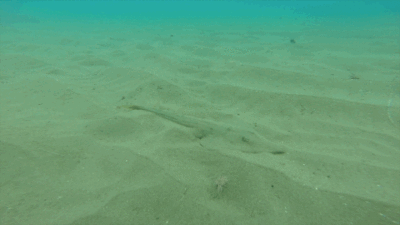
Are you feeling nosy about these weird-looking skates? Don’t worry, we dug up some dirt on the Shovelnose Guitarfish just for you!
 +
+ +
+ +
+ =
=
Image credit: Phil M. Roedel, Common Ocean Fishes of the California Coast
If you want a power chord, make it out of cartilage!
Cartilaginous fishes, or chondricthyans, such as sharks, skates, and rays, don’t have any bones — but they DO have a long spinal rod called a notochord, and bone-like structures resembling vertebrae but made of cartilage instead. Cartilage is softer and more flexible than bone, giving chondrichthyans the great swimming abilities and quick growth rates that make them top predators, or apex predators, in their habitats.
Sharks and rays wish they were cool enough for the SKATE PARK.
Guitarfishes are like a super-hybrid with all the best features of sharks and rays combined. Though they are cartilaginous fishes too, they are neither sharks nor rays but skates, which means they don’t have stingers, generally swim in a snake-like motion using their tail instead of an up and down flapping motion using their pectoral fins, and they are ovoviviparous, which means their young mature inside an egg INSIDE their mother until they are ready to hatch.
There are many types of skates (order Rajiformes, named for that “rajiform” snake-like swimming technique, for you nerds who were wondering), of which guitarfish are just one.
The family nose
Can you guess what the guitarfish family is called?
Here’s a hint: +
+  +
+ /2
/2
If you said Rhinobatinae, the guitarfish family, you’re right! In Greek, rhinos means nose, and batis means ray. Rather than know them forever as ‘nose rays’ (and since they’re not rays at all!) scientists call this family of skates guitarfish. Guitarfish are an amazing hybrid have shark-like dorsal fins can get up to six and a half feet, or two meters, long, and some of them can have litters of 30 young at at time! There might be as many as 60 species in this family including guitarfish, wedgefishes, and fiddler rays. There are even a few species of freshwater guitarfish.
What kind do we see at CIMI?
There are many types of noses found in the guitarfish family, which also includes smooth nose, rough nose, broad nose, widenose, shortnose, and stripenose guitarfish! Here on Catalina Island we see the shovel-nose or pointed-nosed guitarfish, Rhonobatos productus. Shovelnose isn’t an insult — it’s a description of their pointed snout that helps them move through the water and bury themselves when they find a place to hide!
Shovelnose guitarfish can have up to 117 teeth. They are short and pebble-like, so in the unlikely event that a shovelnose bit you, you’d probably just feel a gummy nuzzle (it has only happened once in shovelnose history, and it was reportedly because a diver rudely interrupted a male guitarfish’s date). Since these skates don’t have stingers either, they are one of the safest animals to go hang out with in the water!
Some cool research in 2003 showed that the populations of shovelnose here in the Gulf of California have been isolated so long that they have started to develop genetic distinctions in their mitochondrial DNA (a really important portion of genetic material inherited from your mom). This might make them their own distinct species or sub-species, or tell us they’re on their way to becoming one!
Growing teenagers
These skates never stop growing throughout their lifetime, which is called indeterminate growth. They can live to be up to 16 years old, and the average mass of a shovelnose guitarfish is almost FIFTEEN POUNDS!
School of rock
Some guitarfish swim in large schools. This is not unheard of for chondrichtyans, but it is still interesting to note since many are solitary, territorial creatures.
How do I spot one?
Just look for two tiny holes next to each other on the sandy bottom, opening and closing like little blinking eyes. These are dorsal openings called spiracles, and guitarfish are using them to flush oxygenated water past their gills! They can bury their whole body in sand, but they have to keep their spiracles out to avoid breathing in sand. Gotcha, guitarfish!
What if I need help remembering the name of these pointy skates?
DON’T PANIC. Just tell someone this awful joke, and the shame will burn the shovelnose guitarfish into your memory forever:
What do shovels, noses, and guitars have in common?
They all get picked on.
But someone’s got to stand up for them. In fact, their most recent classification on the IUCN Redlist, the go-to list of threatened and endangered species published by the International Union for Conservation of Nature and Natural Resources, was “Near Threatened” in 2014, though no one has been able to gather accurate data on whether their populations are growing or shrinking. That’s why we picked the mysterious shovelnose to shine the spotlight on today… but we aren’t the only stop on the guitarfish’s tour. Check out their entry in the Animal Diversity Guide or their entry in Fishbase or this page about them on Oceana or this collection of awesome pictures to learn more about these amazing skates!
(all clipart from Clipartpanda.org)


